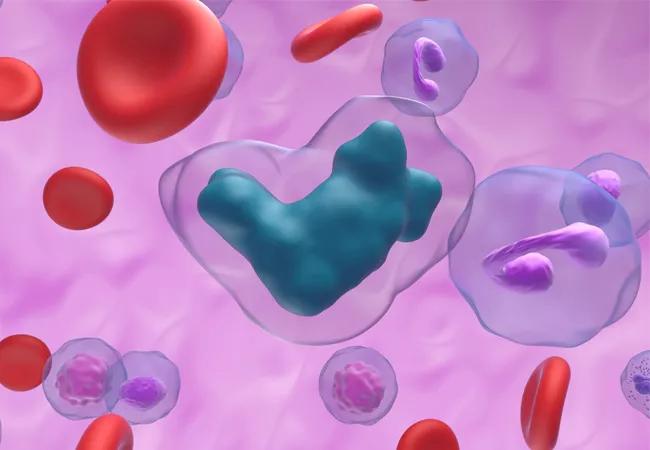Researchers compared tacrolimus/methotrexate to tacrolimus and reduced-dose methotrexate/mycophenolate

Tacrolimus (TAC) and methotrexate (MTX) have long been used to reduce the risk of graft-versus-host disease (GvHD) after allogenic bone marrow transplants, yet these medications often lead to adverse events ranging from liver and kidney toxicity to severe mucositis. In a randomized, phase 3 study, Cleveland Clinic researchers matched standard doses of TAC and MTX against TAC with reduced doses of MTX and mycophenolate (MMF). There were no significant differences in the rates of GvHD between full-MTX and mini-MTX/MMF, while the latter resulted in fewer toxicities and faster engraftment.
Advertisement
Cleveland Clinic is a non-profit academic medical center. Advertising on our site helps support our mission. We do not endorse non-Cleveland Clinic products or services. Policy
Current methods of preventing GVHD include four doses of MTX along with TAC, but clinically significant GvHD still occurs in 30-50% of cases, and often comes with untenable side effects. “There is a need to improve upon this regimen,” says Betty Hamilton, MD, a hematologist/oncologist with Cleveland Clinic and lead author on the study. “Often by the third dose, patients are experiencing painful mouth sores. They are unable to eat or drink and are on pain pumps. This can lead to increased hospitalization stays and holding prophylactic treatment.”
In real-world practice, clinicians will often reduce doses of MTX due to known toxicities, but the reduced-dose regimen has never been formally compared head-to-head with standard doses of TAC and MTX.
In this study, 101 patients aged <70 years undergoing myeloablative allogenic transplant for acute leukemia in remission, myelodysplastic syndromes, chronic myeloid leukemia in chronic state, myeloproliferative neoplasm, non-Hodgkin’s lymphoma, Hodgkin’s lymphoma or multiple myeloma participated in the study. Each patient was randomly selected for arm A or B to either receive the full-dose TAC and MTX or a significantly reduced dose of MTX and MMF.
Participants received TAC at 0.03 mg/kg per day beginning on day -1, with dose adjustments based on the discretion of the treating clinician. In cases with no GvHD, TAC was tapered at approximately day +100, based on clinician discretion. In the full MTX group, MTX was given at 5mg/m(2) IV on day +1,+3, and +6. Dose reduction or held doses occurred for case of renal or liver toxicities or severe mucositis. MMF was given orally on day +1 at 1,000 mg, twice a day. MMF was stopped between day +36 and +45 in cases with no GvHD.
Advertisement
All patients in the mini-MTX/MMF arm received the three planned doses of MTX. In the full MTX arm, 71% received 4 doses, 26% received 3 doses and one patient received two doses.
The primary end points were incidences of GvHD by day 100, severe mucositis during hospitalization and incidence of neutrophil and platelet engraftment by day 28.
Patients receiving the lower dose MTX had fewer instances of grade 3 or 4 mucositis. There was no difference in grade 2-4 acute GvHD or moderate-to-severe chronic GvHD at one year. Patients receiving the lower dose experienced fewer cases of nephrotoxicity or respiratory failure, and had fewer instances of ICU admission. There was no difference in the one-year relapse rate (19% with mini-MTX/MMF vs. 21% with full-dose MTX/TAC) or overall survival (72% with mini-MTX/MMF vs. 71% full-dose MTX/TAC).
Although there was no statistically significant difference in grade 2-4 GvHD (28% with mini-MTX/MMF vs. 27% with full-dose MTX/TAC), there were higher incidences of grade 3-4 GvHD (13 vs. 4%) with mini-MTX/MMF that did not reach statistical significance. “There are many nuances to GvHD prophylaxis in regards to conditioning regimen and other factors,” says Dr. Hamilton. “It’s possible that the increased risk of graft-versus-host disease seen in the mini-MTX/MMF arm may be due to use of peripheral blood stem cells. That’s one area that still needs to be studied. Across institutions, the use of peripheral stem cells seems to be increasing, and we need to determine what is most effective for preventing graft-versus-host disease in those settings.”
Advertisement
Dr. Hamilton noted that there are still unanswered questions regarding the optimal GvHD prophylaxis. A recent large randomized study has demonstrated improved GvHD-relapse-free survival with the use of post-transplant cyclophosphamide compared to TAC/MTX as GVHD prophylaxis in the reduced intensity setting. Additional research is needed to determine optimal prophylaxis in myeloablative conditioning. Many novel approaches are continuing to be investigated to make transplants safer and more effective for patients.
Advertisement
Advertisement

Insights on bringing Cleveland Clinic even closer to becoming the best transplant enterprise in the world

Consensus statement aims to increase use of the perfusion technology and raise transplant volumes

Minimally invasive approach, peri- and postoperative protocols reduce risk and recovery time for these rare, magnanimous two-time donors

Minimally invasive pancreas-kidney replacement reduces patient’s pain, expedites recovery

Largest study to date confirms mortality rates similar to DBD transplant and reveals risk factors

Patient receives liver transplant and a new lease on life

More than 30% of patients die when early dialysis is needed after surgery

AHA recommendations for pretransplant evaluation, peritransplant and long-term management